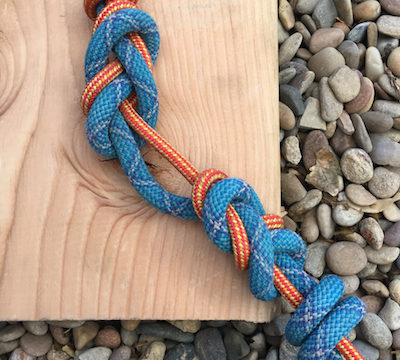
What’s the Best Knot for Tying Rappel Ropes?
- December 2016
- Climb
Let’s talk about rappel knots! Because a lot of people ask me “what’s the best knot for tying rap lines together?” and that’s a darn good question.
The main thing you have to remember about rappelling is no one likes it. Because it’s tedious and/or stressful and a lot of people die because of small mistakes that turn bad.
There’s a lot of great information out there on the cyber about options for rappel knots. The big 3 are the grapevine, double overhand and figure 8 follow through. They all have pros and cons, and the figure 8 follow through is my favorite of the bunch. I have a fourth, even MORE favorite, and then there’s a 5th rappel knot that’s super important in my book, but we’ll get to that last. So let’s go down the list:
1. Grapevine (aka double fisherman’s).
This is a nice knot because it tightens so much it won’t come out. That’s also what’s not so nice about it—it can be really hard to untie again, and that’s the deal breaker for me personally. It can also be a little futzy to tie in the first place. It’s a great knot and perfectly safe, but it’s not my favorite.
2. Double overhand (aka Euro death knot).
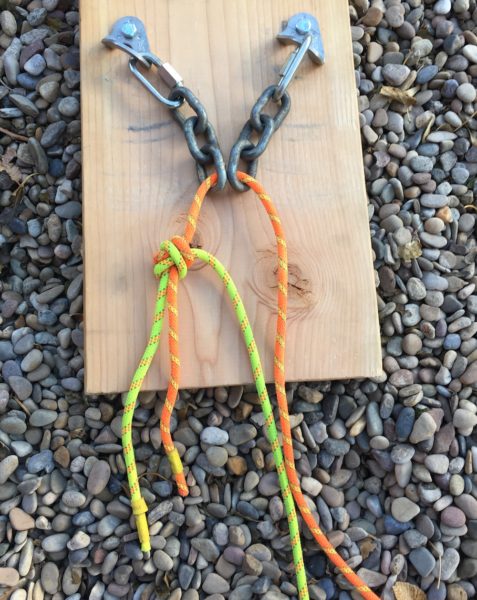
We used to really crack ourselves up about this knot 20 years ago. See, it SHOULD be the fastest knot to tie, but then you have to waste half an hour convincing your partner it’s ok to use, so then you lose all the time you saved tying it. [HAHAHAHA]
If do you use this one you have to leave a foot of tails, and it’s not a bad idea to add a second one just behind the first one as a backup. My friend Topher Donahue (read his Advanced Rock Climbing if you want to learn a ton about knots, techniques and safety) does a backup by adding a second overhand on just one of the tail ends, which I think is neat too. Either way, you might want to do a backup, whichever one you like best.
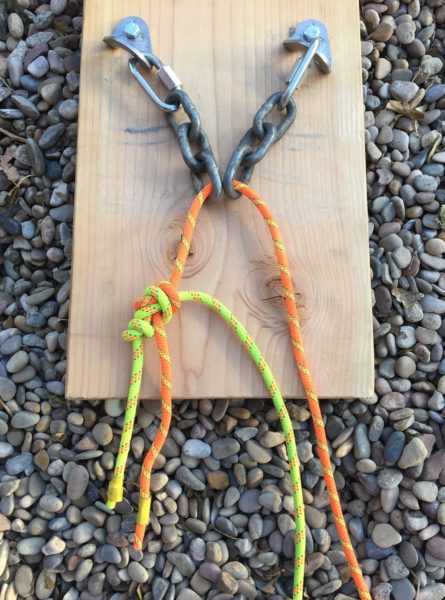
I like the double overhand, but it’s not the knot I’ve used the most for rappelling simply because I rarely climb with double ropes or two ropes of similar diameter. I almost always use a lead rope (usually 9.8 or 10 mm for traditional climbing) plus a 6 mm static tagline (but sometimes thinner or thicker). I was interested to read recently in Topher’s very thorough post about all this and more that it’s officially ok to use a double overhand with two ropes of different diameters (“The flat overhand has been tested to be reliable with ropes of different diameter such as with a 9.5 single lead rope and a 6mm haul line.”) which is definitely not what I’ve always thought. Though it’s apparently safe, the double overhand has always looked janky to me with very different size ropes and the last thing I want when I’m rappelling is the feeling my knot looks janky. So I’ve mainly used:
3. Figure 8 follow through.
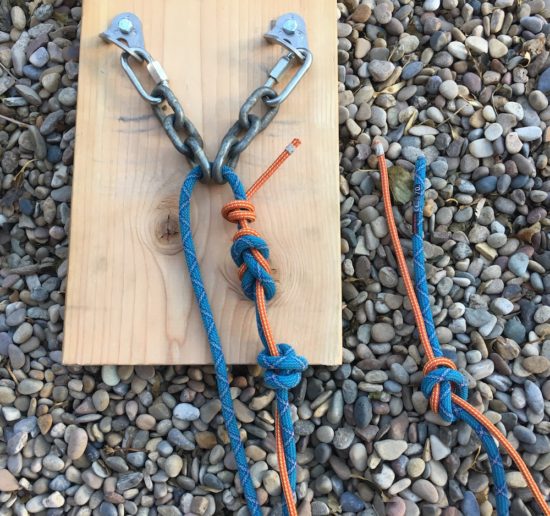
It’s definitely never coming out by itself, you tie it every time you tie into a climbing rope and so you probably won’t mess it up even if it’s dark and storming, and it’s much easier to untie than a grapevine. There’s a reason (well a lot of reasons) the figure 8 is the single most used and trusted knot in climbing. You can also use this same knot to tie ropes together for top roping–another selling point because ‘keep it simple stupid’ is my MO for all situations, which has proven to be a pretty good policy since it’s me I’m dealing with here ;).
But let’s get to the dark horse knot, and my personal favorite:
4. Double figure 8 follow through (aka, paranoid rappeller’s best friend)
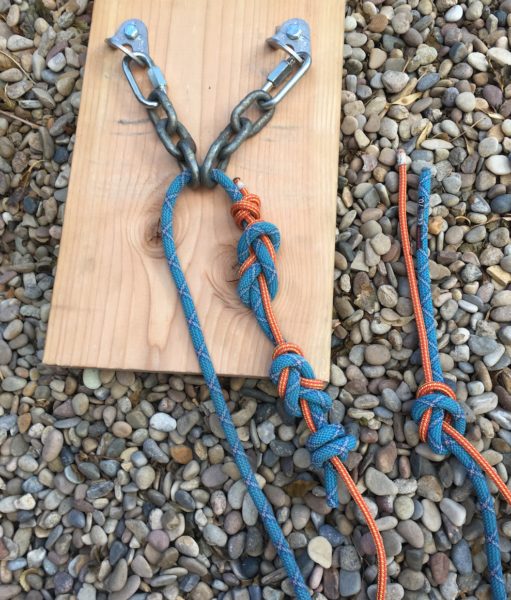
This is a knot I started using when I was climbing a lot in Patagonia. If you’ve climbed there, most of your absolute worst nightmares involve rappelling for hours in storms and things like piton anchors pulling out, ropes blowing sideways and up to be caught on blank sections of wall, your partner suddenly disappearing with the ropes, and having to chop your ropes to make anchors until you’re doing 50 foot rappels down the bottom thousand feet of Torre Egger. And then of course all the normal stuff like knots coming untied or rapping off the ends. So in order to chip away at my growing mountain of rappel related paranoia, I started using a knot that can never untie itself: a double figure 8 follow through. At the same time, it’s always easy to untie (by you, not the rope gremlins).
It creates a larger knot and some people would not like the greater snag potential, which is a legitimate concern. A selling point of the double overhand is the one “flat” side, making it less snaggy when pulling. Personally, I’ve never felt either figure 8 follow through gave me a problem by being more snaggy on the pull, but it could.
It does take a few seconds longer to tie the double figure 8 follow through than a single one, or a double overhand for that matter. To me, donating an extra few seconds to tie your ropes together one time isn’t really a deal breaker. If it’s going to be countless rappels over a multi-hour time period, I’ll trade a few extra seconds of knot tying to get one single thing in the rappel endurathon I don’t have to worry about (i.e. the rope gremlins untying the knot).
For the same reason, the double figure 8 follow through is also a great knot for tying top ropes together. And as a special side bonus, it’s also excellent for tying fixed ropes together (for example, the always core-shotted lines up to Heart Ledge on El Cap). If you leave a little extra slack on one of the sections between the two knots, you won’t have to use a jumar to pass the knot while rappelling (if you’re not rapping with a haulbag), as it gives you a perfect little clip-in point between the lines.
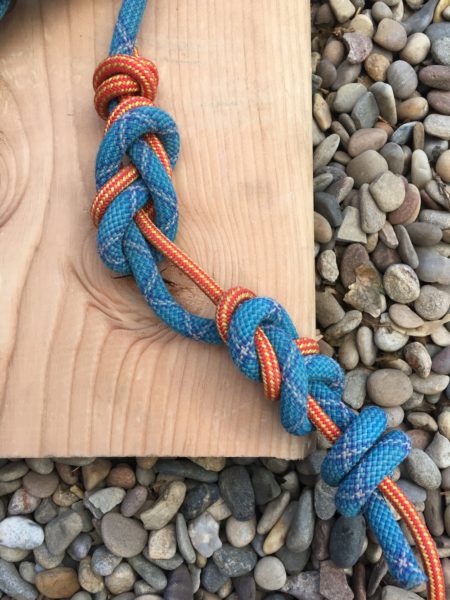
Last but definitely not least, I want to talk about:
5. Double overhand backup for the ENDS of your rap lines (aka, DO THIS!)

You’ll notice in my pictures of the single and double figure 8 follow throughs that the ends of the rap lines are tied in a double overhand. That’s because I like to use it for tying the ends together to make sure I don’t accidentally rap off them.
Some people like to tie one knot in each end—-I would never ever do that because it opens the door for someone (me) to forget to untie one of the knots before pulling the rap lines. It also opens the door to forget to tie one of the knots and this could also lead to not only rapping off the end, but also taking the ropes with you, depending on which side you forgot to tie, which could also put your partner in an equally terrible situation. If none of that ever happens in my life, it will be too soon and that’s why tying separate knots in the ends of lines is against my Rappelling Laws.
If you tie only one knot in both ends you can never ever make either of those mistakes. Well, you can make the first one, but if you do your ropes will still be tied in a closed loop and you can just untie the knot that comes to you and pull them down anyway (instead of proceeding to epic out beyond belief and having debates with your partner about whether anyone should prusik up the rope which is now (possibly) “fixed” at the anchor above you with a single overhand or fisherman’s against a rap ring.)
This backup knot is not going to get caught on something, because if there’s any doubt about that happening (wind, etc), you’re going to rappel with the ends coiled over your lap (another Rappelling Law on the books).
Here’s my bottom line advice about the best knot for rap lines: try different things and figure out which you like best based on your personal preferences and priorities in a given situation. This may be one knot only forever, it will probably be different knots at different times. It’s good to know what different knots have to offer, to make the best decision for you.








I have found that Chinese finger handcuffs work quite well and have the added advantages of being very easy to take apart and not getting stuck very often on rope retrieval.
In fact, if you use the paper version shown in the picture, a good yank will usually tear the handcuffs and separate the ropes.
Just don’t use them if you weigh more than about two pounds.
“The big 3 are the grapevine, double overhand and figure 8 follow through”
The knot you’re referring to as a double overhand is a ‘flat overhand’ bend, commonly known as the EDK. The actual double overhand is a completely different knot, it is a stopper tied in a single strand, not a bend:
http://www.animatedknots.com/doubleoverhand
The double overhand is also essentially the same knot used to ‘backup’ a figure-8 follow through when top-roping at a gym (even though no backup is necessary). Only difference is you’re tying it around the standing end of the rope, so technically it’s a ‘strangle knot’, though I think calling it a double overhand is close enough (and far better than calling it a fisherman’s!)
[…] some extent, I started something. Steph Davis posted an article regarding her favorite rope joining ‘knots’. Steph does make some compelling […]
You’ll find knots referred to by many different names over the years. We’ve always called the “EDK” a double overhand when used as a rappel knot to refer to the fact that you’re tying it with the two rappel lines. Keep your ears and eyes open, and learn as much as you can!
😀 😀
I have a question – I went to the link for Topher’s website about rappel knots, and his says “The flat figure eight knot – shown here, is a “death knot” and has caused accidents. The flat figure eight rolls easily in this configuration and should not be used, ever, for any reason.” What is the difference between the flat figure eight and the figure eight follow through that you show? I can’t see a difference. Thanks!
Never mind – I totally see it. The ends come out different sides with yours! I can see why the other would be totally sketchy 😛
Glad it makes sense now 🙂
Glad it makes sense now 🙂